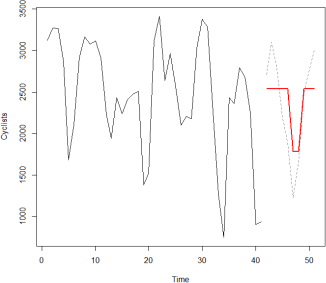Econ 345: Applied Econometrics Forecasting Competition
Hello, dear friend, you can consult us at any time if you have any questions, add WeChat: daixieit
Econ 345: Applied Econometrics Forecasting Competition
The forecasting competition is designed to give you real-world experience of forecasting. As part of the course we are having a real-world forecasting competition – using a model you estimate, you will be predicting time series observations. However, forecast accuracy will not affect your grade. As part of a group, you will submit your forecasts online, together with a short essay (maximum 2 pages) describing your forecasting model and resulting forecasts.
The task is to predict the number of cyclists on the Galloping Goose trail from March 26th to April 1st (inclusive) using the “goose_competition_spring_2024.csv” file. The forecasting competition consists of two parts. Both parts have to be completed to obtain full marks:
1. Write a short report describing your model and resulting forecasts.
2. Submit your forecasts of the number of cyclists via Brightspace.
You may work in groups and write one report (and produce one set of forecasts) as a group, but each student must submit their own copy of the report on Brightspace. Please make sure to include the names and V-numbers of all group members on the report.
Details on both the report and submission of the actual forecasts are provided on the following two pages.
Data to be used as the basis for your forecasts will be posted on Brightspace shortly, however, you can already use the Galloping Goose data on Brightspace to estimate models using last year’s data.
1. Details on the report to be submitted:
As a group, prepare a short report on your forecasting model and resulting forecasts. This should be submitted alongside your forecasts via Brightspace. You may work in groups and write one report as a group, but each student has to submit their own copy of the report on Brightspace. Please make sure to include the names and V-numbers of all group members on the report.
The report should take the form of a short academic essay (avoid casual language, copying R-code, or showing screenshots). A good report would:
i. Have a clear structure, such as:
a. Introduction: introduce the forecasting problem.
b. Data: describe the dataset, any additional variables you maybe using, any apparent patterns, trends etc. including any relevant references.
c. Methods: describe your forecasting model, ideally including an equation that shows
your model. Carefully specify what variables are included and why you include them.
d. Results: if applicable show your in-sample estimated model as a table (similar to the research project formatting) and plot your forecasts in a well-formatted figure,
labelling axes, clearly differentiating between in-sample observations and forecasts. For example:
Figure 1: Observed (black) and predicted (red) cyclists on the Galloping Goose.

e. Conclusion: summarise your results, discuss how your forecasting model could be improved.
ii. Be well-written: do not use casual language, this should be an academic piece of writing.
iii. Be well formatted and presented: do not include screenshots of R-output, do not include R-code. If you present regression results these should either be in the form of an equation (as we have seen in lecture slides) or as a table, and include coefficient estimates, standard errors, and the number of observations.
iv. Be clearly referenced. Make sure to include references to any relevant datasets or literature.
v. Not exceed 2 pages in length (excluding references).
Grading Criteria:
1. Structure & Presentation (50%)
Is the forecast problem/question clearly defined, the paper clearly structured and coherently written?
Are the results presented clearly, with a Figure showing the forecasts (clear labels), and model results shown in either a Table or as an equation?
Note that unlike the research project, students don't have to include hypothesis tests (however, hypothesis tests are of course interesting and encouraged).
2. Technical Correctness, Interpretation, & References (50%)
Is the interpretation and estimation technically correct, and are the results discussed and interpreted carefully? Is the model clearly defined and correctly specified?
Are data and relevant literature properly referenced? (- 10% if no references)
3. Length:
Is the paper within the two-page limit (excl. references)? (-5% per page over limit)
2. Details on the Forecasts to be submitted:
Upload your forecasts on Brightspace by completing the Forecast survey (enter the forecasts for each day).
2024-03-25